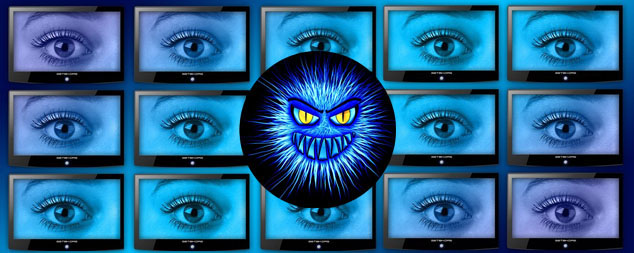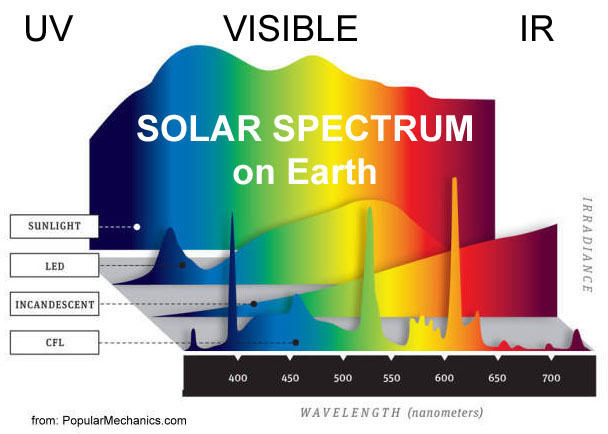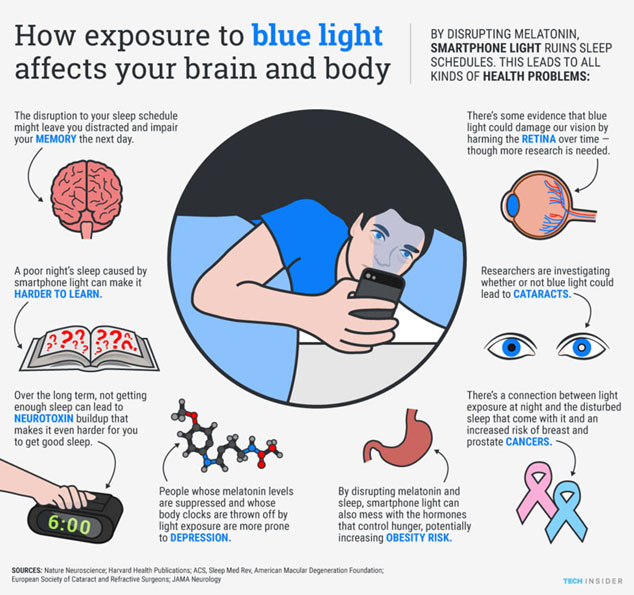 Blue light toxicity might just be the worst health disaster in human history. It should be called Public Health Enemy #1. Yet modern medicine is asleep at the wheel on this one.
Blue light toxicity might just be the worst health disaster in human history. It should be called Public Health Enemy #1. Yet modern medicine is asleep at the wheel on this one.
BEFORE READING ON … ARE YOU, LIKE ME, A SENIOR WHO’S INTERESTED IN STAYING HEALTHY FOR YEARS TO COME? IF SO, YOU MIGHT LIKE TO SEE WHAT A SCIENTIST (ME) HAS TO SAY ABOUT HOW TO ACHIEVE IT AT NO EXTRA COST TO YOU, WITHOUT EVEN HAVING TO LEAVE HOME, STARTING HERE: HEALTHY AGING NATURALLY.
Now back to today’s ‘sponsor’ – killer blue light…
If you’re really bent on ruining your health and shortening your life, this post isn’t for you.
If you’re more interested in taking steps against probably the most pernicious destroyer of human health in modern times, then keep reading.
This post completes my two-part series on the health impacts of blue light.
Part 1 was about the ‘Dr. Jekyll’ of blue light – aka, the good guy. (See: BLUE LIGHT – Your Best Friend or your Worst Enemy?)
Part 2 here is about the ‘Mr. Hyde’ of blue light – aka, the murderous alter ego it becomes.
Since this already may be a bit confusing, let me be perfectly clear what this issue is all about…
The Main Problem
To clarify, take a look once again at the spectrum of light we and all our ancestors adapted to during the 3.2 billion years of life on Earth:

The main point I made in Part 1 is that blue light is of great benefit when it comes with all the other colors of the sun’s rainbow.
Conversely, blue light out of proportion to the rest of the rainbow causes tremendous damage to our physiology.
As you can see, that’s what we get from modern artificial lighting, starting with CFLs and other types of ‘white’ fluorescent lighting.
The high-blue spectrum of tech devices is much worse. TVs, laptops and tablets, and cell phones are the most common sources of exposure to excessive, out-of-balance blue light.
As I’ll explain below, it disrupts virtually all the molecular timing mechanisms we rely on for good health.
Which leads to all the major diseases of modern times.
It explains the dramatic rise incidences of cancer, diabetes, and brain damage now afflicting modern humans.
It’s the main accelerant for faster aging and shorter lifespans.
And it’s worse for young people, since their brains and nervous systems aren’t even fully mature until about age 25.
If you know kids whose faces are constantly in their cell phones, they have become magnets for what used to be referred to as ‘age-related’ diseases. Diabetes is appearing more often in children. Cancers are appearing sooner. And don’t even get me started on early onset Alzheimer’s Disease (AD is now being referred to as Type 3 diabetes – geez!)
Yes, we are talking about a major, major health disaster that’s been in the making for decades.
The Johnnie-Come-Latelies of Modern Medicine
While research has continually shown the health hazards of a blue-lit world, you won’t hear about them from your doctor. In fact, doctors’ offices, clinics, and hospitals are all horrible places with all their high-blue lighting.
At best, you might be warned about eye damage. At least in part.
You’ll mostly hear about AMD (age-related macular degneration).
It’s now well known that blue light destroys the eye by distorting a specific form of vitamin A. The assault day after day (like most of us experience with our daily use of screens, phones, and LED lights) is what’s behind AMD.
However, you probably won’t hear about how cataracts are a defensive mechanism against too much blue light. (Cataracts are formed by the condensation of a yellowish lens protein that partially blocks blue light – yellow filters out the blue … pretty cool, eh?)
A More Complete View
What exactly does high-blue lighting do?
Of all the well-known types of damage, the leading one is the destruction of the so-called sleep hormone, melatonin.
I say ‘so-called’ because melatonin is much more than a sleep hormone. It’s mainly a brain repair hormone.
And it only works at night, in the dark, during sleep.
You start making it in your brain’s pineal gland first thing in the morning. Then at dusk the gland starts to release the hormone in preparation for nighttime sleep.
Unfortunately, melatonin is very sensitive to light, especially blue light. Specifically, blue light destroys it.
Now, while you may be unconscious during the night, truly good sleep depends on keeping your melatonin levels up. I.e., not ruining them with blue light in the evening.
[This seems to explain why blue light at night leads to brain damage – e.g., Alzheimer’s Disease. It completely undermines the ability of the brain’s nighttime melatonin-dependent repair mechanisms to work properly.]
The net effect of nighttime blue light is essentially to tell your brain it’s daytime.
This disruption of your circadian rhythms (day-night physiology) adds to the damage by boosting your cortisol levels. This effect becomes a source of physiological stress – since cortisol is the ‘stress’ hormone.
Cortisol is often described as the ‘fight or flight’ hormone. Our ancestors depended on it for instant response to escape attacks by saber-toothed tigers, as the story goes.
Now, since all the saber-toothed tigers I know of are stuck in the La Brea tar pits in southern California, elevated cortisol levels make you feel like you’re under attack by them anyway. (Same goes for any other modern sources of stress.)
The Hidden Epidemic of Blue Light
No matter how conscientious you are about your health – good diet, good exercise, good nutrition, inter alia – you may still be suffering from chronic health problems.
This may be you…

In fact, more than likely it is you.
Now, as scary as all that might be (and it should be), the question becomes – what can you do about it?
Getting Your ‘Blue-Lit” Life in Order
Nothing else you do for your own health will be as effective as you want it to be until you address this issue.
If you’re a night owl, work the swing shift, use electronic gadgets all day long and into the night, watch modern TVs, or are surrounded by typical fluorescent lighting, you must make better choices.
Of course, changing jobs or isolating yourself from such modern conveniences may not be the easiest thing to do, in spite of the health benefits in doing so. The least you can do is replace fluorescent lights (including CFLs and LEDs) with low-blue equivalents.
In our home we take additional steps, such as using yellow ‘bug lights’ (i.e., low blue) as bedside reading lamps. (Red would be even better, although they can be a little too dark.)
We also replaced our kitchen fluorescent tubes with softer lights, then taped a semi-clear yellow tape over them to reduce blue even further. It sure gives the kitchen a nice yellow glow, which I really like.
You can also wear blue-blocking glasses (i.e., orange/amber) when you watch TV, use your cell phone, or sit in front of your laptop, notebook, or e-reader.
Some pretty inexpensive blue blockers are available on Amazon and elsewhere. When I’m at my desk I wear blue-blocking clip-ons on my computer glasses (ca. $15 a pair). When I watch TV at night I wear blue blocking goggles that fit over my regular glasses (ca. $8 a pair).
Lots of other, pricier, blue blockers are also available, although they’re not better than the less expensive ones I use.
Make all the changes you can as soon as possible.
Remember:
Blue light is only okay when it’s combined with full-spectrum sunlight. It goes hand in hand with infrared for all those health benefits of the full solar spectrum I explained in Part 1 of this report.
One More Thing
High-blue lighting does damage all day long and into the night.
In addition, almost any artificial light at night (ALAN) will also add to the disruption of your circadian rhythms.
Your most effective strategy would be to avoid turning on any kind of lights after sundown. And to keep them off all night long.
Yeah, right … who’s gonna do THAT?
Just do whatever you can to keep the lights and tech devices turned off as much as you can at night.
BTW…this includes digital clocks in your bedroom. At best, you can use only those with red-lit readouts.
Comments or Questions?
I’d love to hear from you. This and every other post here provides a comment section at the end of the post, exactly for that purpose.
So, by all means, leave me your thoughts.
I would be especially grateful if you point out any flaws in my logic, factual errors, or ordinary typos. (I’ll give you a little ‘huzzah’ in my heart.)
Then I’ll respond as soon as I can.
References
Figueiro MG, Wood B, Plitnick B, Rea MS. The impact of light from computer monitors on melatonin levels in college students. Neuro Endocrinol Lett. 2011;32(2):158-63. PMID: 21552190. https://pubmed.ncbi.nlm.nih.gov/21552190/
Gabel V, Reichert CF, Maire M, Schmidt C, Schlangen LJM, Kolodyazhniy V, Garbazza C, Cajochen C, Viola AU. Differential impact in young and older individuals of blue-enriched white light on circadian physiology and alertness during sustained wakefulness. Sci Rep. 2017 Aug 8;7(1):7620. doi: 10.1038/s41598-017-07060-8. PMID: 28790405; PMCID: PMC5548856. https://www.ncbi.nlm.nih.gov/pmc/articles/PMC5548856/
Gooley JJ, Chamberlain K, Smith KA, Khalsa SB, Rajaratnam SM, Van Reen E, Zeitzer JM, Czeisler CA, Lockley SW. Exposure to room light before bedtime suppresses melatonin onset and shortens melatonin duration in humans. J Clin Endocrinol Metab. 2011 Mar;96(3):E463-72. doi: 10.1210/jc.2010-2098. Epub 2010 Dec 30. PMID: 21193540; PMCID: PMC3047226. https://www.ncbi.nlm.nih.gov/pmc/articles/PMC3047226/
Harvard Health Publishing. July 7, 2020. Blue light has a dark side. https://www.health.harvard.edu/staying-healthy/blue-light-has-a-dark-side
Lee HS, Cui L, Li Y, Choi JS, Choi JH, Li Z, Kim GE, Choi W, Yoon KC. Influence of Light Emitting Diode-Derived Blue Light Overexposure on Mouse Ocular Surface. PLoS One. 2016 Aug 12;11(8):e0161041. doi: 10.1371/journal.pone.0161041. Erratum in: PLoS One. 2016 Nov 30;11(11):e0167671. PMID: 27517861; PMCID: PMC4982597. https://www.ncbi.nlm.nih.gov/pmc/articles/PMC4982597/
Münch M, Nowozin C, Regente J, Bes F, De Zeeuw J, Hädel S, Wahnschaffe A, Kunz D. Blue-Enriched Morning Light as a Countermeasure to Light at the Wrong Time: Effects on Cognition, Sleepiness, Sleep, and Circadian Phase. Neuropsychobiology. 2016;74(4):207-218. doi: 10.1159/000477093. Epub 2017 Jun 22. PMID: 28637029. https://pubmed.ncbi.nlm.nih.gov/28637029/
Ramsey DJ, Ramsey KM, Vavvas DG. Genetic advances in ophthalmology: the role of melanopsin-expressing, intrinsically photosensitive retinal ganglion cells in the circadian organization of the visual system. Semin Ophthalmol. 2013 Sep-Nov;28(5-6):406-21. doi: 10.3109/08820538.2013.825294. Epub 2013 Sep 6. PMID: 24010846. https://pubmed.ncbi.nlm.nih.gov/24010846/
Ratnayake K, Payton JL, Lakmal OH, Karunarathne A. Blue light excited retinal intercepts cellular signaling. Sci Rep. 2018 Jul 5;8(1):10207. doi: 10.1038/s41598-018-28254-8. PMID: 29976989; PMCID: PMC6033873. https://www.ncbi.nlm.nih.gov/pmc/articles/PMC6033873/
Rose KA, Morgan IG, Ip J, Kifley A, Huynh S, Smith W, Mitchell P. Outdoor activity reduces the prevalence of myopia in children. Ophthalmology. 2008 Aug;115(8):1279-85. doi: 10.1016/j.ophtha.2007.12.019. Epub 2008 Feb 21. PMID: 18294691. https://pubmed.ncbi.nlm.nih.gov/18294691/
Wei X, She C, Chen D, Yan F, Zeng J, Zeng L, Wang L. Blue-light-blocking intraocular lens implantation improves the sleep quality of cataract patients. J Clin Sleep Med. 2013 Aug 15;9(8):741-5. doi: 10.5664/jcsm.2908. PMID: 23946702; PMCID: PMC3716663. https://www.ncbi.nlm.nih.gov/pmc/articles/PMC3716663/
Xie C, Li X, Tong J, Gu Y, Shen Y. Effects of white light-emitting diode (LED) light exposure with different correlated color temperatures (CCTs) on human lens epithelial cells in culture. Photochem Photobiol. 2014 Jul-Aug;90(4):853-9. doi: 10.1111/php.12250. Epub 2014 Feb 25. PMID: 24483628. https://pubmed.ncbi.nlm.nih.gov/24483628/
Zhao ZC, Zhou Y, Tan G, Li J. Research progress about the effect and prevention of blue light on eyes. Int J Ophthalmol. 2018 Dec 18;11(12):1999-2003. doi: 10.18240/ijo.2018.12.20. PMID: 30588436; PMCID: PMC6288536. https://www.ncbi.nlm.nih.gov/pmc/articles/PMC6288536/#b11
All the best in natural health,

Statements on this page have not been evaluated by the Food and Drug Administration. Information here is not is not intended to diagnose, treat, cure, or prevent any disease.
I may receive a commission for purchases made through those links.
This doesn’t change the cost to you.
Dear Dennis,
Wow. Cataracts!! I know someone in her 40s who recently had cataract surgery done in both eyes but in separate dates for each eye.
In regards to interior lighting use, I’ve been getting warm white in 3000 Kelvin.
Thank you, and take care!
It is amazing, isn’t it, Anyimar? The yellowish protein in a cataract is designed to filter out blue light. Having it removed, without mitigating blue light exposure, is just asking for more trouble.
Cheers,
Dennis